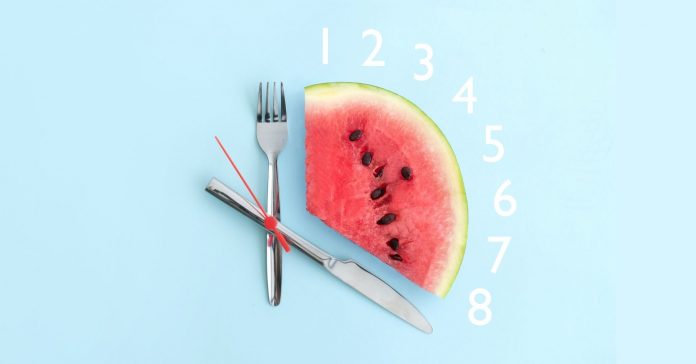The trend of intermittent fasting has recently become popular. There is a belief that it can make people lose weight, improve metabolic health, and extend their lifespan.
It depends on each individual which method will work best for them, but every method can be effective.
These eating patterns can be categorized in several ways. A healthcare professional should be consulted before you decide how often to fast or embark on an intermittent fast.
Here are six popular ways to do intermittent fasting.
1. The 16/8 method
According to this method, you fast every day for approximately 16 hours, while limiting what time you eat to approximately 8 hours per day. During your eating window, you can consume two, three, or more meals.
This method is also known as the Leangains protocol and was popularized by fitness expert Martin Berkhan. This method of fasting can actually be accomplished by simply skipping breakfast and not eating after dinner. For example, if you finish your last meal at 8 p.m. and don’t eat until noon the next day, you’re technically fasting for 16 hours.
Those who like to eat breakfast in the morning may find this method difficult to adjust to. However, many breakfast skippers instinctively eat this way.
While fasting, it may be useful to drink water, coffee, and any other zero-calorie beverages so you don’t feel hungry.
During your eating window, it’s very important to eat primarily healthy foods. Processed foods and excessive calories will undermine the effectiveness of this method.
2. The 5:2 diet
In the 5:2 diet, you eat as you normally would 5 days a week and restrict your calories to 500–600 for 2 days. This diet is also called the Fast Diet and was popularized by British journalist Michael Mosley. On the fasting days, it is recommended that women eat 500 calories and men eat 600 calories.
During the week, for example, you might eat normally except for Mondays and Thursdays. Women consume 250 calories each and men consume 300 calories each during those 2 days. The 5:2 diet has been found to be effective for weight loss
3. Eat Stop Eat
The Eat Stop Eat method involves fasting for 24 hours once or twice a week. This method was popularized by fitness expert Brad Pilon and has been quite popular for a few years.
A 24-hour fast is equivalent to going without food for 24 hours straight from dinner to dinner. For example, if you finish dinner at 7 p.m. Monday and don’t eat until dinner at 7 p.m. Tuesday, you’ve completed a full 24-hour fast. You can also fast from breakfast to breakfast or lunch to lunch — the end result is the same.
While fasting, water, coffee, and other zero-calorie drinks are permitted, but solid foods are not. During the eating period, it’s very important that you stick to your regular diet if you’re doing this to lose weight. This means that you should eat as much food as if you hadn’t been fasting at all.
The downside to this method is that many people may have difficulty fasting a full 24 hours. The first step does not have to be all in. It’s okay to start with 14-16 hours, then move upward from there.
4. Alternate-day fasting
Alternate-day fasting involves fasting every other day.
The method is available in several versions. In some cases, the fasting days are allowed 500 calories. However, one small study found alternate-day fasting did not appear to be any more effective than a typical eating plan.
For beginners, it’s not recommended to complete a full fast every other day. The downside of this method is that you may go to bed hungry several times a week, which isn’t pleasant and probably unsustainable.
5. The Warrior Diet
The Warrior Diet was popularized by fitness expert Ori Hofmekler. Small amounts of raw fruits and vegetables are eaten during the day, while one large meal is consumed at night. In essence, you fast during the day and feast at night within a 4-hour window.
Diets like the Warrior Diet were among the first to include intermittent fasting. Its food choices are quite similar to those of the paleo diet – mostly whole, unprocessed foods.
6. Spontaneous meal skipping
Intermittent fasting doesn’t have to be followed in a structured manner to benefit from it. You may also skip meals from time to time, for instance when you don’t feel hungry or are too busy to cook and eat.
However, some people eat every few hours lest they hit starvation mode or lose muscle. Some bodies can survive long periods of famine and may miss one or two meals occasionally. Ultimately, only you know what is best for you.
You can skip breakfast one day if you aren’t hungry. Instead, eat a healthy lunch and dinner. In this case, if there is no good food available where you are travelling, you may be able to fast for a short time.
A spontaneous intermittent fast is basically skipping one or two meals when you feel inclined to do so. Keep healthy, balanced meals on hand during non-fasting times.
In conclusion, intermittent fasting can be a weight-loss tool that works for some people. There is no guarantee that it will work for everyone.
It’s not recommended for people who have or are prone to eating disorders. It may also pose a problem for those who have underlying health issues.
Keep in mind that diet quality is very important if you decide to try intermittent fasting. During the eating periods, you cannot consume ultra-processed foods and expect to lose weight and improve your health. Additionally, you should consult your healthcare provider before starting an intermittent fast.


